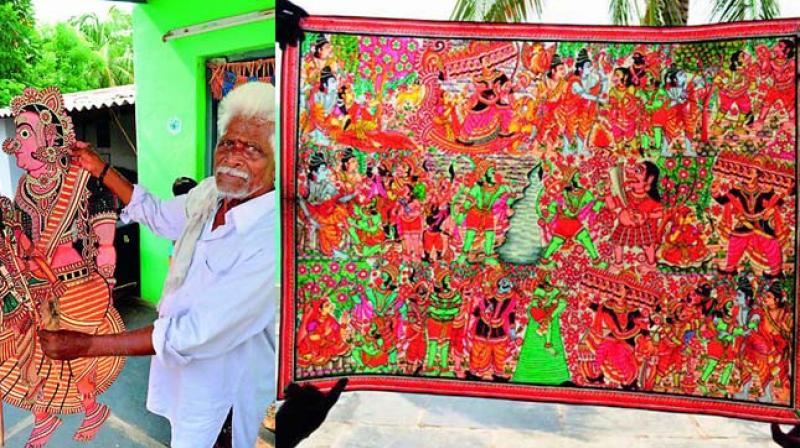Tracing the roots of the dancing leather puppets

Hyderabad: Tholu Bommalata (leather puppet show) is a dying art. And then, Sindhe Sriram puts up a five-minute, foot-tapping show in the heat of the afternoon, and leaves one wondering why it is the art is dying out.
High decibel music, harmonium blasting, mini cymbals keeping talam (beat) and everyone singing behind the screen. It is not an easy task. The lady moving the puppets on huge straw sticks has to dance along with the puppets, which range from three to six feet in height. For the viewer it is enchanting, a colourful tale from the Puranas brought live on stage.
There was a time when rural folk finished with their day’s labour, wiped the sweat off their face, had their meal for the evening and sat down to watch a world of wonderful and colourful stories from the Ramayana and the Mahabharata.
Those were summer months, when there was no farm work and the evenings were dull and hot. In exchange, the puppeteers would get rice and other grains, a place to stay and, sometimes, money. Those were good times. When communities depended on one another, respecting the other’s space. That kind of puppetry show has now stopped.
Tholu Bommalata literally means “the dance of leather puppets”. Mr Sriram still does puppet shows, that is when he is invited to do so. It might be for a government function or invitations to other places where culture is still put on show.
Four to five people are needed to give the audience a colourful and intricately woven story and so he and his team of four, including his wife, mother-in-law and two others have travelled to Delhi, Visakhapatnam, Hyderabad, Chennai and other places.
“We perform close to 20 programmes per year,” he says, which is encouraging at one level. But they are the only ones doing shadow puppetry shows and that is not good news.
It is normally a two-hour programme and stories of valour and wars are shown on the 'thirai' or white screen. They perform the Sundarakanda, Myravana Charitra, Lakshmana Murcha, Sati Sulochana and Ravana Vadha and probably many others.
Each puppet is controlled by one person with the help of a bamboo stick attached to the back, while the singing goes on. Apparently, movements of the puppets are intricate with the larger puppets having up to 13 different movable body joints. Fight scenes bring tempo into the performance, giving the crowd the kick they want.
Performances would go on for hours and, sometimes, the entire night. If the epics like the Ramayana and the Mahabharata had to be retold, it could take days. But those have stopped completely. Now, bulbs are used instead of earthen lamps, which added a certain romance as the shadows grew or reduced in size in the dark of the night. There was also a feeling then among people that if the Ramayana was told in the form of a puppet show, there would be good rain.
Nimallakunta lies on the way to Puttaparthi from Dharmavaram in AP's Anantapur district. Other than the fact that it is on the highway and speeding vehicles are a constant, the place is clean, the people look happy and everyone is occupied, doing work on leather, including puppets. Leather puppets were once linked to the traditional folk and culture, known as tollubommalu and, when used to entertain, as tollubommalata.
Mr Dalavai Chalapati Rao is the 78-year-old veteran, winner of several awards and one among the best known leather puppet makers at Nimallakunta. “We belong to a separate caste called Chitrakar, a BC B category, and we have all come from Maharashtra and settled down here,” he says.
Nimmalakunta in Anantapur district, Narsaraopet in Guntur district and D.C. Palle in Nellore district are the only places where leather puppets are made, but in Nimmalakunta, artisans practise this as a hereditary craft.
Dalavai seems to be the family name in this village and many homes have this surname. The whole family is involved in this work. At Mr Chalapati Rao’s home, Ramana, the eldest son stays at home and works on the puppets.
Since there are no performances now, folks are continuously preparing stock for taking to exhibitions, or to fill orders for shops and exports
History says that this art originated in 200 BC under the rule of the Satavahana dynasty. Workshops are conducted in many places where people are taught to make other leather products, which are marketable and look attractive. This includes hangings, book marks, lamp shades, etc.
While they might make some money and keep the tradition alive, there are many who say that they have become like puppets, to the vagaries of people's desires. Children are educated and many have taken up jobs, but then there are also those who stay at home and continue with the tradition, as in all traditional jobs, arts and crafts.
AP is known for several art traditions, which is part of a rich folklore tradition, deep rooted in the ethos of the state’s rural landscape. Leather puppets are one of them. The show still goes on.

